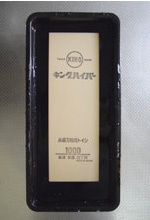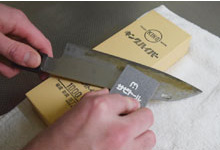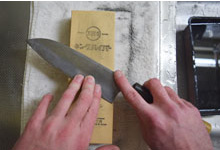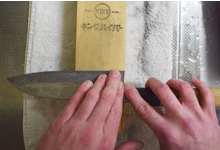Maintenance
Use and maintenance
A knife is above all a tool for cutting, especially Japanese blades, which are thin and hard with superior slicing power and longevity. Depending on the alloy and the forge, the blade's features will differ. Therefore, do not use your knife in any old way, and follow these precautions to ensure it lasts as long as possible.
Never use your knife to cut frozen products, bones or materials that are too hard. Avoid twisting or applying lateral pressure to the blade because certain very hard alloys are brittle.
Always use a knife that is appropriate to the task. For bones, use only deboning knives. For things with hard peels such as pineapples, choose a saw knife to preserve the sharpening. Use scissors to trim brochette sticks in order to avoid micro-nicks.
In order to clean your knife, use simply a sponge with a little dish soap under hot running water. Avoid abrasive pads so that you do not scratch the blade, and corrosive cleaning products that could stain the steel. Never put your knife in the dishwasher and do not let it soak in water.
After cleaning, dry the blade well with a clean towel. Take care to always clean and dry your knife after using it, especially if it is not made from stainless steel, since it could become pitted with rust. If you are not going to use your knife for a long time, protect the blade with a thin layer of camellia or other oil.
Finally, sharpen your knife regularly and always at the same angle on a whetstone. Never use a sharpening steel, which will round the edge of the blade. I do not recommend using an electrically powered stone or grinding machine because the result is mediocre.
If your blade should rust or get scratched over the years, do not wait too long. There are specialized products to give new life to your knife. Similarly, if the point or heel of your knife breaks, you can always repair the damage using a simple whetstone.
In addition to our blade sharpening services, we can also repair damaged blades. Do not hesitate to ask us for advice.
Sharpening
Introduction
Traditional Japanese whetstone sharpening is an art that used to be practiced by almost everyone who had a knife. For a time reserved for sushi masters and specialists, this art is reappearing in Japanese homes. Indispensable tools for maintaining blades, whetstones are used by all knife lovers who want to keep their blades sharp.
Preparation
Required tools:
-Whetstones
-A holder or damp towel
-A basin or pan of water
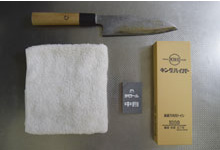

- 250-800: Large grit designed to reshape the edge of the blade and do the rough work before moving on to a finer grit stone.
- 1000-2500: Medium grit used to resharpen the blade and make it an efficient cutting tool again.
- 5000-1000: Not obligatory, but useful for polishing your blade and making the edge even finer.





